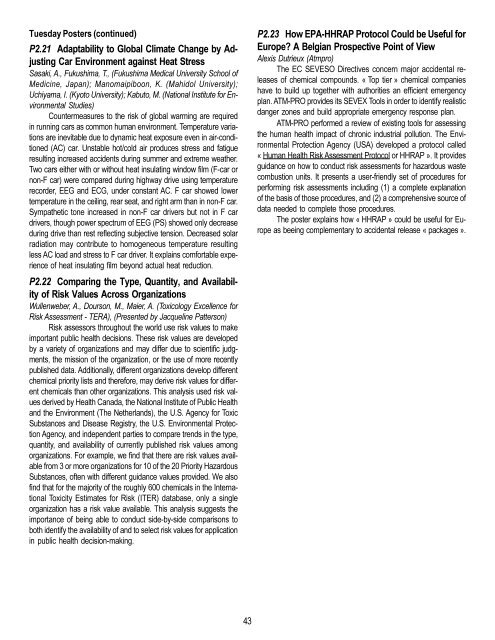Final Program World Congress on Risk - The Society for Risk Analysis
Final Program World Congress on Risk - The Society for Risk Analysis
Final Program World Congress on Risk - The Society for Risk Analysis
Create successful ePaper yourself
Turn your PDF publications into a flip-book with our unique Google optimized e-Paper software.
Tuesday Posters (c<strong>on</strong>tinued)<br />
P2.21 Adaptability to Global Climate Change by Adjusting<br />
Car Envir<strong>on</strong>ment against Heat Stress<br />
Sasaki, A., Fukushima, T., (Fukushima Medical University School of<br />
Medicine, Japan); Manomaipibo<strong>on</strong>, K. (Mahidol University);<br />
Uchiyama, I. (Kyoto University); Kabuto, M. (Nati<strong>on</strong>al Institute <strong>for</strong> Envir<strong>on</strong>mental<br />
Studies)<br />
Countermeasures to the risk of global warming are required<br />
in running cars as comm<strong>on</strong> human envir<strong>on</strong>ment. Temperature variati<strong>on</strong>s<br />
are inevitable due to dynamic heat exposure even in air-c<strong>on</strong>diti<strong>on</strong>ed<br />
(AC) car. Unstable hot/cold air produces stress and fatigue<br />
resulting increased accidents during summer and extreme weather.<br />
Two cars either with or without heat insulating window film (F-car or<br />
n<strong>on</strong>-F car) were compared during highway drive using temperature<br />
recorder, EEG and ECG, under c<strong>on</strong>stant AC. F car showed lower<br />
temperature in the ceiling, rear seat, and right arm than in n<strong>on</strong>-F car.<br />
Sympathetic t<strong>on</strong>e increased in n<strong>on</strong>-F car drivers but not in F car<br />
drivers, though power spectrum of EEG (PS) showed <strong>on</strong>ly decrease<br />
during drive than rest reflecting subjective tensi<strong>on</strong>. Decreased solar<br />
radiati<strong>on</strong> may c<strong>on</strong>tribute to homogeneous temperature resulting<br />
less AC load and stress to F car driver. It explains com<strong>for</strong>table experience<br />
of heat insulating film bey<strong>on</strong>d actual heat reducti<strong>on</strong>.<br />
P2.22 Comparing the Type, Quantity, and Availability<br />
of <strong>Risk</strong> Values Across Organizati<strong>on</strong>s<br />
Wullenweber, A., Dours<strong>on</strong>, M., Maier, A. (Toxicology Excellence <strong>for</strong><br />
<strong>Risk</strong> Assessment - TERA), (Presented by Jacqueline Patters<strong>on</strong>)<br />
<strong>Risk</strong> assessors throughout the world use risk values to make<br />
important public health decisi<strong>on</strong>s. <strong>The</strong>se risk values are developed<br />
by a variety of organizati<strong>on</strong>s and may differ due to scientific judgments,<br />
the missi<strong>on</strong> of the organizati<strong>on</strong>, or the use of more recently<br />
published data. Additi<strong>on</strong>ally, different organizati<strong>on</strong>s develop different<br />
chemical priority lists and there<strong>for</strong>e, may derive risk values <strong>for</strong> different<br />
chemicals than other organizati<strong>on</strong>s. This analysis used risk values<br />
derived by Health Canada, the Nati<strong>on</strong>al Institute of Public Health<br />
and the Envir<strong>on</strong>ment (<strong>The</strong> Netherlands), the U.S. Agency <strong>for</strong> Toxic<br />
Substances and Disease Registry, the U.S. Envir<strong>on</strong>mental Protecti<strong>on</strong><br />
Agency, and independent parties to compare trends in the type,<br />
quantity, and availability of currently published risk values am<strong>on</strong>g<br />
organizati<strong>on</strong>s. For example, we find that there are risk values available<br />
from 3 or more organizati<strong>on</strong>s <strong>for</strong> 10 of the 20 Priority Hazardous<br />
Substances, often with different guidance values provided. We also<br />
find that <strong>for</strong> the majority of the roughly 600 chemicals in the Internati<strong>on</strong>al<br />
Toxicity Estimates <strong>for</strong> <strong>Risk</strong> (ITER) database, <strong>on</strong>ly a single<br />
organizati<strong>on</strong> has a risk value available. This analysis suggests the<br />
importance of being able to c<strong>on</strong>duct side-by-side comparis<strong>on</strong>s to<br />
both identify the availability of and to select risk values <strong>for</strong> applicati<strong>on</strong><br />
in public health decisi<strong>on</strong>-making.<br />
P2.23 How EPA-HHRAP Protocol Could be Useful <strong>for</strong><br />
Europe? A Belgian Prospective Point of View<br />
Alexis Dutrieux (Atmpro)<br />
<strong>The</strong> EC SEVESO Directives c<strong>on</strong>cern major accidental releases<br />
of chemical compounds. « Top tier » chemical companies<br />
have to build up together with authorities an efficient emergency<br />
plan. ATM-PRO provides its SEVEX Tools in order to identify realistic<br />
danger z<strong>on</strong>es and build appropriate emergency resp<strong>on</strong>se plan.<br />
ATM-PRO per<strong>for</strong>med a review of existing tools <strong>for</strong> assessing<br />
the human health impact of chr<strong>on</strong>ic industrial polluti<strong>on</strong>. <strong>The</strong> Envir<strong>on</strong>mental<br />
Protecti<strong>on</strong> Agency (USA) developed a protocol called<br />
« Human Health <strong>Risk</strong> Assessment Protocol or HHRAP ». It provides<br />
guidance <strong>on</strong> how to c<strong>on</strong>duct risk assessments <strong>for</strong> hazardous waste<br />
combusti<strong>on</strong> units. It presents a user-friendly set of procedures <strong>for</strong><br />
per<strong>for</strong>ming risk assessments including (1) a complete explanati<strong>on</strong><br />
of the basis of those procedures, and (2) a comprehensive source of<br />
data needed to complete those procedures.<br />
<strong>The</strong> poster explains how « HHRAP » could be useful <strong>for</strong> Europe<br />
as beeing complementary to accidental release « packages ».<br />
43
















